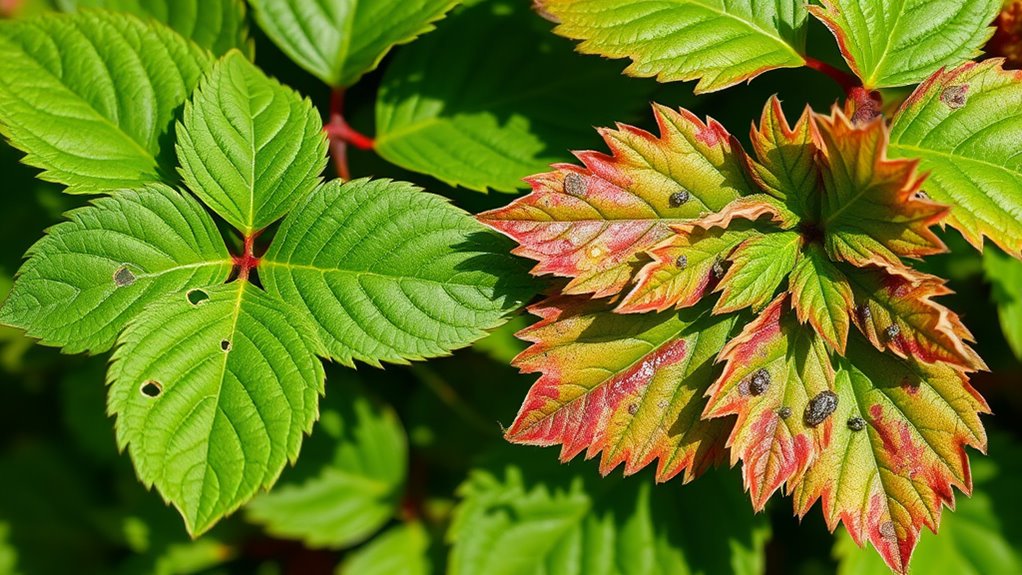You’ll find that American cranberrybush viburnum resists leaf beetle damage much better than the European variety. The European type is more vulnerable to beetle attacks, leading to more significant defoliation and plant stress. If you want to minimize pest problems, choosing American varieties can be helpful. Understanding these differences can make managing your shrubs easier—keep exploring to discover more effective ways to protect your plants from leaf beetles.
Key Takeaways
- European cranberrybush viburnum is more susceptible to leaf beetle damage than American varieties.
- American cranberrybush viburnum shows better natural resistance to leaf beetle infestations.
- European types require more vigilant pest monitoring and management efforts.
- Leaf beetle attacks cause more severe defoliation on European cranberrybush viburnum.
- Native American varieties benefit from natural predators, reducing beetle impact.

The cranberrybush viburnum is especially vulnerable to the leaf beetle, which can cause significant damage if left unchecked. This beetle poses a serious threat because it targets the plant’s leaves, leading to defoliation that weakens the shrub and hampers its growth. If you’re cultivating cranberrybush viburnums, understanding the differences between American and European varieties can help you better manage this pest. The European cranberrybush viburnum tends to be more susceptible to the leaf beetle compared to the American type, which shows some natural resistance. Recognizing these differences is vital because it influences your pest management strategies.
Invasive species like the leaf beetle can quickly become a problem if they aren’t controlled early. They often arrive without natural predators, allowing their populations to explode rapidly. This makes proactive pest management essential. When you notice signs of beetle activity, such as chewed leaves or the presence of beetles and frass, it’s time to act. For European cranberrybush viburnums, you might need to implement more aggressive controls, including targeted insecticides or biological controls, to prevent severe defoliation. Meanwhile, the American varieties might tolerate some beetle activity better but still require monitoring to prevent outbreaks.
Effective pest management starts with regular inspection. Look for small holes in the leaves, larvae, or adult beetles on the plant’s surface. Handpicking beetles can be effective for small infestations, especially in early stages. For larger problems, consider using insecticidal sprays or introducing natural predators like parasitic wasps, which can help keep beetle populations in check without harming other beneficial insects. Keep in mind that chemical controls should be used judiciously to avoid disrupting the local ecosystem.
Monitoring and early intervention are your best defenses against leaf beetle damage. The European cranberrybush viburnum’s higher susceptibility means you’ll need to be more vigilant if you cultivate this variety. Maintaining healthy plants through proper watering, pruning, and fertilization can also make your shrubs less attractive to pests. Remember, the key to successful pest management lies in early detection and tailored approaches. By staying vigilant and acting promptly, you can protect your cranberrybush viburnums from the destructive effects of leaf beetles, especially in areas where invasive species threaten native plant health. Additionally, understanding the role of natural predators in controlling pest populations can be a crucial part of an integrated pest management strategy.
Frequently Asked Questions
How Can I Prevent Leaf Beetle Infestations Naturally?
To prevent leaf beetle infestations naturally, you should encourage beneficial insects like ladybugs and lacewings that prey on beetles. Practice companion planting by growing aromatic herbs such as garlic, chives, or marigolds near your viburnum, which can repel beetles. Regularly inspect your plants for early signs of damage, and remove any beetles or affected leaves by hand to keep their numbers in check.
Are There Organic Treatments Effective Against These Beetles?
Yes, organic treatments can be effective against leaf beetles. You should try companion planting with aromatic herbs like marigolds or basil, which repel beetles. Additionally, attracting beneficial insects like ladybugs and lacewings can naturally control beetle populations. Spray a neem oil solution or insecticidal soap as needed, but make sure to promote a healthy ecosystem that supports these natural predators to keep beetle numbers in check.
Do Beetles Prefer American or European Cranberrybush Viburnum?
You might be surprised to learn that leaf beetles are more attracted to American cranberrybush viburnum than European varieties. Their preference for the American plant stems from lower plant resistance, making it easier for beetles to feed and reproduce. So, if you’re trying to deter these pests, understanding beetle attraction and choosing the more resistant European viburnum could be your best defense against infestation.
What Signs Indicate a Severe Beetle Infestation?
You’ll notice a severe beetle infestation by significant defoliation on your cranberrybush viburnum, which causes the plant to look heavily stripped or skeletonized. Additionally, look for the presence of beetle larvae on the undersides of leaves or around stems. These signs indicate the beetles are thriving and you’ve got a serious problem that needs prompt treatment to prevent further damage.
How Often Should I Monitor My Viburnum for Pests?
Think of monitoring your viburnum like checking a child’s schoolwork—regular, attentive, and timely. You should inspect your plants every 7-10 days during the growing season for pest detection. This consistent monitoring frequency helps catch leaf beetles early, preventing severe damage. Keep an eye on new growth and undersides of leaves, so you can act swiftly if pests appear. Staying vigilant guarantees your viburnum stays healthy and vibrant.
Conclusion
Think of cranberrybush viburnum as a delicate dance partner—you want it to shine without being tripped up by pests. American cranberrybush viburnum shows more vulnerability to leaf beetles, like a dancer with a fragile step, while European varieties stand firmer on their toes. Knowing these differences helps you choose the right plant for a pest-free garden. With this knowledge, you can keep your landscape thriving like a well-choreographed performance, free of unwelcome surprises.









